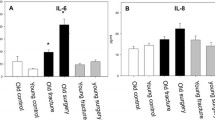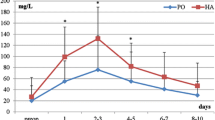Abstract
Purpose
Interleukin-6 is a mainly proinflammatory interleukin and an indicator for the magnitude of surgery. The IL-6 serum concentration correlates with injury severity, the extent of tissue trauma and has negative impact on prognosis. To date it is unclear whether the immunologic changes assessed are age dependent. The aim of this study is to compare the surgical inflammatory response in different age groups.
Methods
Data were collected at a level-1 university trauma center in a prospective, consecutive cohort study. IL-6 levels were analyzed via ELISA from venous blood samples of cohorts of injuries with typical peak incidence: patients with unstable fractures of the spine (SP) for a middle-aged group and patients with fractures of the proximal femur (PF) for a geriatric group. Surgical treatment was performed using minimal-invasive instrumentation.
Results
25 patients in group SP (age: 51 years ± 20) and 16 patients in the group PF (age: 73 years ± 16) were analysed. Group PF showed higher baseline IL-6 concentrations. Surgical treatment was followed by a significant increase of IL-6 levels in both groups 4 and 24 h postoperatively. Concentration profiles were similar, but increase was significantly higher in the PF group 4 h after surgery.
Conclusion
Both the operative treatment of fractures in a middle-aged (SP) and a geriatric group (PF) lead to significant increasing of IL-6 levels. In view of a comparative surgical burden, these data suggest that age may be a confounding factor for a surgery induced pro-inflammatory response in the early postoperative stage.

Similar content being viewed by others
References
Lozano R, Naghavi M, Foreman K, Lim S, Shibuya K, Aboyans V, et al. Global and regional mortality from 235 causes of death for 20 age groups in 1990 and 2010: a systematic analysis for the Global Burden of Disease Study 2010. Lancet. 2012;380(9859):2095–128.
Keel M, Trentz O. Pathophysiology of polytrauma. Injury. 2005;36(6):691–709.
Lenz A, Franklin GA, Cheadle WG. Systemic inflammation after trauma. Injury. 2007;38(12):1336–45.
Lord JM, Midwinter MJ, Chen YF, Belli A, Brohi K, Kovacs EJ, et al. The systemic immune response to trauma: an overview of pathophysiology and treatment. Lancet. 2014;384(9952):1455–65.
Pape HC, Griensven MV, Hildebrand FF, Tzioupis CT, Sommer KL, Krettek CC, et al. Systemic inflammatory response after extremity or truncal fracture operations. J Trauma. 2008;65(6):1379–84.
Cruickshank AM, Fraser WD, Burns HJ, Van Damme J, Shenkin A. Response of serum interleukin-6 in patients undergoing elective surgery of varying severity. Clin Sci (London, England: 1979). 1990; 79(2):161–5.
Franceschi C, Capri M, Monti D, Giunta S, Olivieri F, Sevini F, et al. Inflammaging and anti-inflammaging: a systemic perspective on aging and longevity emerged from studies in humans. Mech Ageing Dev. 2007;128(1):92–105.
Nomellini V, Gomez CR, Gamelli RL, Kovacs EJ. Aging and animal models of systemic insult: trauma, burn, and sepsis. Shock. 2009;31(1):11–20.
Leucht P, Fischer K, Muhr G, Mueller EJ. Epidemiology of traumatic spine fractures. Injury. 2009;40(2):166–72.
al-Nuaim AR, Kremli M, al-Nuaim M, Sandkgi S. Incidence of proximal femur fracture in an urbanized community in Saudi Arabia. Calcif Tissue Int. 1995; 56(6):536–8.
Pape HC, Schmidt RE, Rice J, Vangriensven M, Dasgupta R, Krettek C, et al. Biochemical changes after trauma and skeletal surgery of the lower extremity: quantification of the operative burden. Crit Care Med. 2000;28(10):3441–8.
Shaw AC, Goldstein DR, Montgomery RR. Age-dependent dysregulation of innate immunity. Nat Rev Immunol. 2013;13(12):875–87.
Zhu S, Patel KV, Bandinelli S, Ferrucci L, Guralnik JM. Predictors of interleukin-6 elevation in older adults. J Am Geriatr Soc. 2009;57(9):1672–7.
Butcher SK, Killampalli V, Lascelles D, Wang K, Alpar EK, Lord JM. Raised cortisol:DHEAS ratios in the elderly after injury: potential impact upon neutrophil function and immunity. Aging Cell. 2005;4(6):319–24.
Sun TS, Chen XB, Liu Z, Ma ZY, Zhang JZ. Relationship between the operation time of multiple fractures with system inflammation changes and clinical outcomes. Zhonghua wai ke za zhi [Chin J Surg]. 2008;46(13):961–5.
Vester H, Huber-Lang MS, Kida Q, Scola A, van Griensven M, Gebhard F, et al. The immune response after fracture trauma is different in old compared to young patients. Immun Ageing I & A. 2014;11(1):20.
Kim HO, Kim HS, Youn JC, Shin EC, Park S. Serum cytokine profiles in healthy young and elderly population assessed using multiplexed bead-based immunoassays. J Trans Med. 2011;9:113.
Li H, Manwani B, Leng SX. Frailty, inflammation, and immunity. Aging Dis. 2011;2(6):466–73.
Author information
Authors and Affiliations
Corresponding author
Ethics declarations
Ethical Approval
The study protocol was approved by the Ethics Committee oft the Medical Faculty of the RWTH Aachen (Reference Number 10-027, EK004/11) and was conducted according to the ethical standards of the Declaration of Helsinki (1964) and its amendments. In all cases informed consent was obtained by the patient or close relatives.
Conflict of interest
Mathias Thaeter, Matthias Knobe, Michiel Vande Kerckhove, Franziska Böhle, Eddy Verhaven, Hans-Christoph Pape declare that they have no conflict of interest.
Rights and permissions
About this article
Cite this article
Thaeter, M., Knobe, M., Vande Kerckhove, M. et al. Perioperative inflammatory response in major fracture: do geriatric patients behave differently?. Eur J Trauma Emerg Surg 42, 547–551 (2016). https://doi.org/10.1007/s00068-016-0719-9
Received:
Accepted:
Published:
Issue Date:
DOI: https://doi.org/10.1007/s00068-016-0719-9




